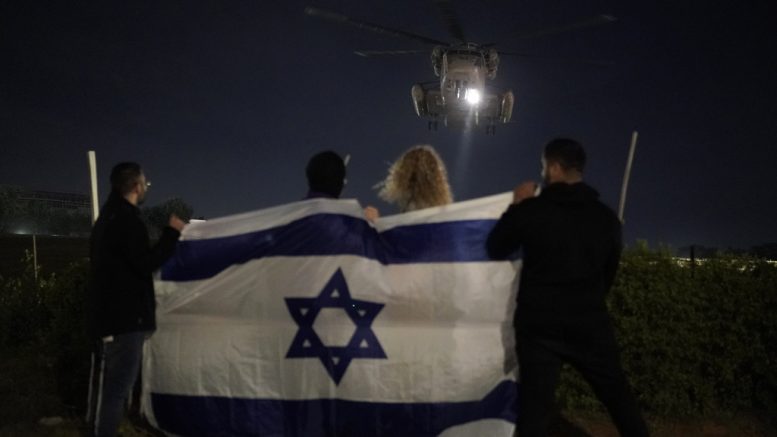RAFAH, Gaza Strip (AP) — International mediators appeared to make progress Wednesday on extending the truce in Gaza, encouraging Hamas militants to keep freeing hostages in exchange for the release of Palestinian prisoners and further relief from Israel’s air and ground offensive. The cease-fire will otherwise end within a day.
Israel has welcomed the release of dozens of hostages in recent days and says it will maintain the truce if Hamas keeps freeing captives. But it also says it is committed to its other major goal — the annihilation of the armed group that has ruled Gaza for 16 years and orchestrated the deadly attack on Israel that triggered the war — however hard that might be.
Weeks of heavy aerial bombardment and a ground invasion have demolished vast swaths of northern Gaza and killed thousands of Palestinians. But it seems to have had little effect on Hamas’ rule, evidenced by its ability to conduct complex negotiations, enforce the cease-fire among other armed groups, and orchestrate the smooth release of hostages.
Yehya Sinwar and other Hamas leaders have likely relocated to the south, along with hundreds of thousands of displaced Palestinians who have packed into overflowing shelters.
An Israeli ground invasion of the south could eventually ferret out Hamas’ leaders and demolish the rest of its militant infrastructure, including kilometers (miles) of tunnels, but at a cost in Palestinian lives and destruction that the United States, Israel’s main ally, could be unwilling to bear.
The Biden administration has told Israel that if it resumes the offensive it must operate with far greater precision, especially in the south. That approach could make it more difficult to bring Hamas to its knees any time soon, and international pressure for a lasting cease-fire is already mounting.
“How far both sides will be prepared to go in trading hostages and prisoners for the pause is about to be tested, but the pressures and incentives for both to stick with it are at the moment stronger than the incentives to go back to war,” Martin Indyk, a former U.S. ambassador to Israel, wrote on X.
DIPLOMACY RAMPS UP
Diaa Rashwan, head of Egypt’s state information services, said negotiations to extend the cease-fire and release more hostages have made progress and that it is “highly likely” another extension will be announced Wednesday. Egypt, along with Qatar and the U.S., played a key role in mediating the original cease-fire and a two-day extension announced Monday.
Secretary of State Antony Blinken, who plans to visit the region this week, said the U.S. would like to see an extension of the truce, the release of more hostages, and the delivery of more humanitarian aid to Gaza.
Speaking to reporters in Brussels, he said he also wanted to discuss postwar arrangements for Gaza, a subject on which the U.S., Israel and Arab countries are deeply divided.
The war began with Hamas’ Oct. 7 attack into southern Israel, in which it killed over 1,200 people, mostly civilians. The militants dragged some 240 people back into Gaza, including babies, children, women, soldiers, older adults and Thai farm laborers.
Israel responded with a devastating air campaign across Gaza and a ground invasion in the north. More than 13,300 Palestinians have been killed, roughly two-thirds of them women and minors, according to the Health Ministry in Hamas-ruled Gaza, which does not differentiate between civilians and combatants.
The toll is likely much higher, as officials have only sporadically updated the count since Nov. 11 due to the breakdown of services in the north. The ministry says thousands more people are missing and feared dead under the rubble.
Israel says 77 of its soldiers have been killed in the ground offensive, and it claims to have killed thousands of militants, without providing evidence.
ISRAEL’S HOSTAGE DILEMMA
The plight of the captives, and the lingering shock from the Oct. 7 attack, has galvanized Israeli support for the war. But Prime Minister Benjamin Netanyahu is also under intense pressure to bring the hostages home, and could find it difficult to resume the offensive if there’s a prospect for more releases.
Israel said Wednesday that around 160 hostages are still being held in Gaza, including four who are under 18 and 10 who are over 75. With information hard to come by, authorities have only given approximate counts of the number of hostages held in Gaza.
There appear to remain enough to potentially extend the current cease-fire for another two weeks. Israel did not say how many of the captives are soldiers, for whom Hamas is expected to drive a much harder bargain.
The cease-fire is currently due to end at some point after an exchange planned for later on Wednesday.
A total of 60 Israelis have been freed as part of the truce, most of whom appear physically well but shaken. Another 21 hostages — 19 Thais, one Filipino and one Russian-Israeli — have been released in separate negotiations since the truce began. Before the cease-fire, Hamas released four hostages, and the Israeli army rescued one. Two others were found dead in Gaza.
The latest swap brought to 180 the number of Palestinians freed from Israeli prisons. Most have been teenagers accused of throwing stones and firebombs during confrontations with Israeli forces. Several were women convicted by Israeli military courts of attempting deadly attacks.
Palestinians have celebrated the release of people they see as having resisted Israel’s decadeslong military occupation of lands they want for a future state.
TENSE CALM IN GAZA
Ordinary Palestinians fear the resumption of the war, which has brought unprecedented levels of death, destruction and displacement across Gaza.
“We are fed up,” said Omar al-Darawi, who works at the overwhelmed Al-Aqsa Martyrs hospital in central Gaza. “We want this war to stop.”
Israel’s bombardment and ground offensive have displaced more than 1.8 million people inside Gaza, nearly 80% of the territory’s population, and most have sought refuge in the south, according to the U.N.
The cease-fire has allowed more aid to be delivered to Gaza, up to 200 trucks a day, but that is less than half what the enclave was importing before the fighting, even as needs have soared. People stocking up on fuel and other basics have had to wait for hours in long lines that form before dawn.
As U.N.-run shelters have overflowed, many have been forced to sleep on the streets outside in cold, rainy weather. The head of the World Health Organization warned Wednesday that “more people could die from disease than bombings.”
Dr. Tedros Adhanom Ghebreyesus said some 111,000 people have respiratory infections and 75,000 have diarrhea, more than half of them under 5 years old. He, too, urged a sustained truce, calling it “a matter of life and death.”





























